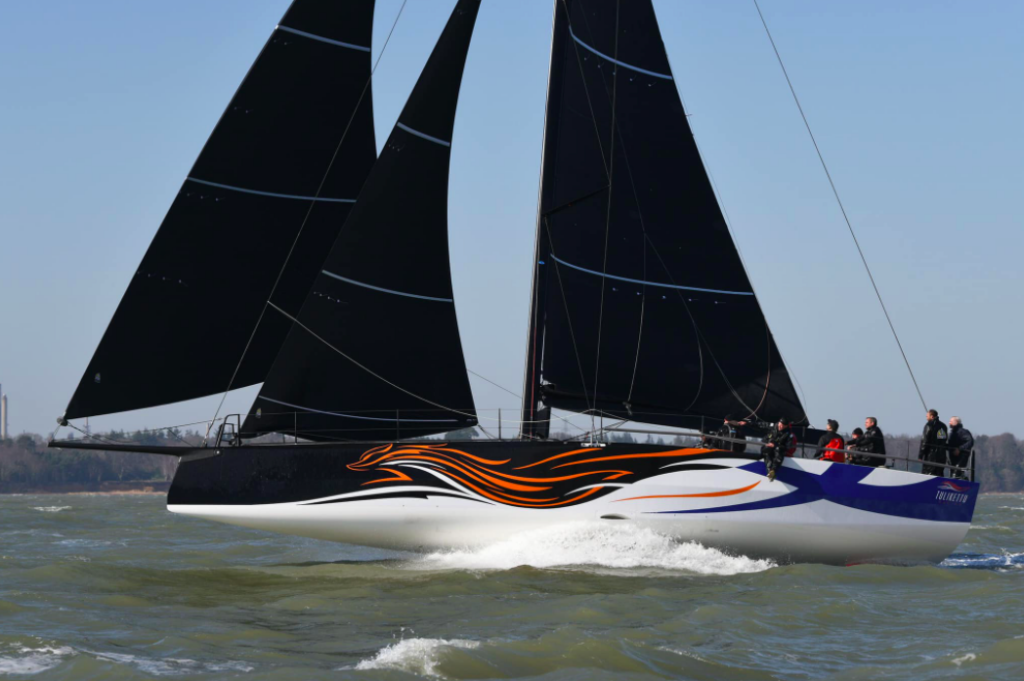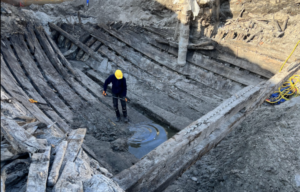Tributes pour in for Tulikettu after crew’s dramatic rescue

Tributes continue to pour in for Tulikettu, the Infiniti 52, after she sunk in the North Atlantic, last month (18 April).
The yacht was sailing from Cascais, Portugal back to the team base in Gosport, when it collided with an unidentified floating object (UFO). Two days later the entire crew was evacuated to an oil tanker, and Tulikettu was abandoned at sea. All four delivery crew members survived unharmed.
“Unfortunately, we are seeing more instances of collisions with foreign objects at sea, and the effects this is having on the health of our oceans and the sailing community,” says Brian McInnes of Composite Builders, who built the yacht.
A high-powered tug was sent to search the area with direct assistance from a spotter plane the next day. The search pulled in a multinational team, which produced daily drift calculations to assist the sea and air recovery specialists. After a week of intensive searching, the Tulikettu team stopped the search on 29 April.
“I have been through many sleepless nights as I have wondered what else we could have done to find our beautiful new beast,” says Arto Linnervuo, racing team owner. However, Finnish news site Helsingin Sanomat reports that the boat had a locator that did not work when its batteries got wet.
Sailing Anarchy has called for a hold on speculation about the incident. There are no details on whether the UFO collided with the boat head-on or whether it was the foil leading to damage to the casing. Any comment on this would be unhelpful, says the website, and as such would not only be wise but only fair to wait until the team and those involved in the incident clarify their views of what happened.
Support has been overwhelming for the team and what it hoped, and hopes, to achieve on social media.
“Setbacks are part of this sport… with the attitude you have, sure you will make it,” says one commentator on Instagram, and “I am confident you will turn this as an opportunity to grow stronger than ever,” says another.
Questions are being asked about the boat’s construction. “I would be interested to know whether the boat had internal floatation (foam, airbags) and watertight compartments,” says one Facebook user. “It is labelled as a high speed offshore racing yacht which means when collisions with objects in the water (rubbish, big fish, tree-trunks, etc) happen at speed structural damage will occur and watertight integrity will be lost. I hope that any lessons learnt will find their way into the sister ships and later models.”
Given that the crew waited two days before launching the EPIRB, it seems likely that those onboard hoped Tulikettu would be able to limp back to base.
“The boat ended sadly. This was a crushing setback for the project, but I haven’t even considered it coming to an end. A new chapter begins,” Linnervuo told Helsingin Sanomat.
“We realised that such activities have their own risks and dangers. Our safety system played and the crew was brought to safety. There are all kinds of roaring at sea. We don’t even guess what it could have been.
“Now there is a lot of paperwork and laundry left to be washed away. It was fortunate in the accident that we had time to sail the boat for almost 5000 nautical miles. We showed that the boat meets, and even exceeds, the requirements for achieving our goals.”
The next model, and her international pedigree, is a popular theme.
“She was magnificent and creating her was a huge international effort. Hope you manage to rebuild in good time,” says one commentator on Facebook.
“The vessel can be replaced and I would expect at a higher specification given the opportunity to do that. Best get busy. I would love to see an SRW rig on an Infinity yacht,” says one, and “Version 2 will be an opportunity to get absolutely everything perfect on the insurance company’s dime,” says another.
“I will never forget the feeling when Tulikettu leaned on its foil and lifted herself above the waves for the first time reaching effortlessly boat speeds of 28 knots without help from surf waves, and the wind speed didn’t come even close to our boat speed back then,” says Linnervuo.
“Very slowly my thoughts are beginning to look at the future, which gives me strength in this devastating situation. Loosing such a revolutionary vessel that had attracted so much attention and interest across the global sailing community is, after many years’ work, one of the most difficult moments in my life, but giving up on our goals and my dream to win something big together with my all-Finnish offshore racing team on the international grand prix offshore racing scene would be much worse.”
Linnervuo says the team’s collaboration with Infiniti Yachts will continue. Meanwhile, it’ll continue to train and compete with other offshore racing yachts (Xtra Stærk Ocean Racing Society) and will potentially charter other competitive boats.
Designed by Hugh Welbourn, the Infiniti 52 is the first foil-assisted high-performance/racing yacht developed for semi-custom production. Marine Industry News reported on her sea trials just a few weeks ago.
“The Infiniti 52 showed every sign of being the best yacht to have been fitted with DSS ever. Her behaviour and balance were impeccable and speed easy to find. Having spent so long developing and building the Tulikettu her loss is a significant disappointment, notwithstanding hull two is well underway and hull three is expected to start in a few weeks,” says Gordon Kay, founder of Infiniti Yachts.
“I speak for the whole team at Composite Builders and all of the people involved in getting Tulikettu on the water, how heartbroken we are to hear of the unfortunate accident with this beautiful yacht. In its short life the boat’s performance had exceeded expectations. . . We are happy that the crew are safe and hope to see Arto and his team back on the water very soon,” comments McInnes.










